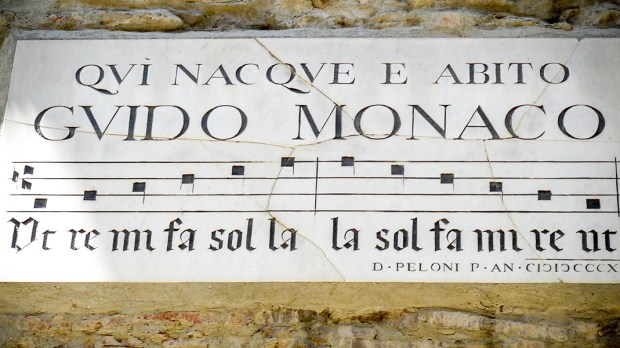Maybe you thought the names of the musical notes originated with Maria von Trapp, making up songs to entertain her stepchildren-to-be as they rode their bicycles through the Austrian countryside. But the real origin is much older.
Modern musical notation was born around 1025 in Pomposa, on the Adriatic shore of Ferrara in Italy, when the Benedictine monk and music theorist Guido D’Arezzo noticed his fellow monks had difficulties remembering the melodies they were supposed to sing while praying the liturgy.
Arezzo’s system (the very same one we use nowadays, basically consisting of a five-line staff, four spaces and seven notes in different octaves), replaced neumatic notation, which consisted of certain indications regarding pitch and rhythm patterns which would allow the singer to follow the needed changes in articulation, duration or tempo as related to their own breathing capacities. In fact, the word neumatic derives either from the Greek pneuma, meaning “breath,” or neuma, meaning “sign.” In the early days of the Church, for instance, such neumatic notation was used to notate inflections in the ekphonetic (that is, “quasi-melodic”) recitation of the Scriptures.
Guido D’Arezzo’s Micrologus (his musical treatise, which became the second most-widely distributed text on music in the Middle Ages) included what we nowadays know as staff notation, prescribing the use (and names) of our seven musical notes: ut-re-mi-fa-so-la-si. (It was Giovanni Battista Doni who changed ut to do and si to ti later on, in the 18th century). D’Arezzo took the names of the first six notes in acrostic fashion from the first six half-lines of a hymn dedicated to St. John The Baptist, the Ut queant laxis: “UT queant laxis, RE sonare fibris, MIra gestorum, FAmuli tuorum, SOlve pollute, LAbii reatum” (“So that your servants may, with loosened voices, resound the wonders of your deeds, clean the guilt from our stained lips”).
The seventh note, SI, was formed using the initials of Saint John, “Sancte Ioannes” in Latin. But it was added a bit later on, in order to complete the diatonic scale.
If you want to listen to the Ut queant laxis, feel free to play the video below.

